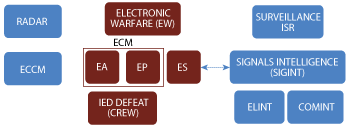 |
| AGARD Handbook EW Components |
: Added: Dec 08, 2014 12:03 pm
Description
The U.S. Army Research, Development and Engineering Command (RDECOM), Communications-Electronic Research, Development and Engineering Center (CERDEC) is conducting this RFI todetermine the availability and development status of technologies to support an Electronic Countermeasure (ECM) technique effectiveness laboratory infrastructure
Topics of Interest
We are specifically seeking input on the following topics:- Radar countermeasure EA technique development
- Radar system EP technique development
- In-lab EA/EP technique effectiveness testing
- Target generator that accounts for environmental effects (e.g. clutter)
- ECM generation
- Noise and coherent techniques
- Direct inject and free space radiation capability (both input and output)
- Open architecture and software reprogrammable
- Radar system simulator/signal processing model
- Direct inject and free space radiation capability (both input and output)
- Programmable parameters/output
- Radar emulator
- Software programmable for EP technique development
- Acquire and track target from generator
- Input of EA signal from jammer
- Effect of jamming on signal processing
- Connections/Interfaces
- Command and control system
Responses
Interested parties are requested to respond to this RFI with a white paper. All information is requested within twenty-one (21) days of announcement via email to usarmy.apg.cerdec.mbx.i2wd-ewags-rfi@mail.mil
:
Related References:
A Cost-Effective Approach to Simulation for Electronic Warfare Systems | 2014-08-15 | Microwave Journal |
| The application space and sub-elements of EW |
Electronic Warfare (EW), in general, involves denying an enemy use of the Electromagnetic Spectrum (EMS) or gathering intelligence of an enemy’s intended actions or capabilities through analysis of electromagnetic (EM) signals they may transmit, either intentionally or unintentionally. Simulation of the spectral environments encountered by an EW system in the field is a complex undertaking and the need for anThe Utility of Advanced Distributed Simulation for Electronic Warfare Systems Testing
effective and validated operational test capability cannot be underestimated, while tight budgets introduce a new dimension of complexity. This article discusses the EW environment, the EW test and evaluation process, and off-the-shelf alternatives for simulation requirements.
EW comprises three areas of application:
and operates with other types of systems − specifically Intelligence, Surveillance and
- Electronic Attack (EA),
includes jamming of threats using everything from high power barrage techniques to selective deception techniques that offer the advantage of not jamming your own side’s systems as well as your adversaries. Weapon systems are also part of electronic attack in the form of High Speed Anti-radiation missiles (HARM) in addition to actively transmitting decoys.- Electronic Protection (EP) involves managing the spectrum you are using to find clear and safe areas of operation and to ensure your own systems are not overly vulnerable to electronic attack from your adversaries. It also involves control of your own emissions such that your own signals don’t provide a beacon for enemy
fire, and- Electronic Support (ES) includes systems that are termed Electronic Support Measures (ESM) that provide threat warning, Signal collection and cataloging, and direction finding (DF) where we’ll use the adversary’s emissions to locate them.
Reconnaissance (ISR), and radar (see Figure).
ADA592761 Electronic Warfare Test and Evaluation
This handbook is intended as an introductory text dedicated to EW systems T&E. While other volumes in the Flight Test Techniques Series have provided limited coverage of EW system testing, they have been generally aimed at a broad view of T&E and have not resulted in a singular focused handbook on EW test techniques.
No comments:
Post a Comment